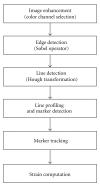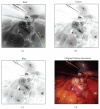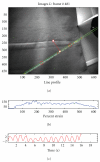Visual measurement of suture strain for robotic surgery
- PMID: 21436874
- PMCID: PMC3049425
- DOI: 10.1155/2011/879086
Visual measurement of suture strain for robotic surgery
Abstract
Minimally invasive surgical procedures offer advantages of smaller incisions, decreased hospital length of stay, and rapid postoperative recovery to the patient. Surgical robots improve access and visualization intraoperatively and have expanded the indications for minimally invasive procedures. A limitation of the DaVinci surgical robot is a lack of sensory feedback to the operative surgeon. Experienced robotic surgeons use visual interpretation of tissue and suture deformation as a surrogate for tactile feedback. A difficulty encountered during robotic surgery is maintaining adequate suture tension while tying knots or following a running anastomotic suture. Displaying suture strain in real time has potential to decrease the learning curve and improve the performance and safety of robotic surgical procedures. Conventional strain measurement methods involve installation of complex sensors on the robotic instruments. This paper presents a noninvasive video processing-based method to determine strain in surgical sutures. The method accurately calculates strain in suture by processing video from the existing surgical camera, making implementation uncomplicated. The video analysis method was developed and validated using video of suture strain standards on a servohydraulic testing system. The video-based suture strain algorithm is shown capable of measuring suture strains of 0.2% with subpixel resolution and proven reliability under various conditions.
Figures












References
-
- Gerhardus D. Robot-assisted surgery: the future is here. Journal of Healthcare Management. 2003;48(4):242–251. - PubMed
-
- Mack MJ. Minimally invasive and robotic surgery. Journal of the American Medical Association. 2001;285(5):568–572. - PubMed
-
- Shennib H, Bastawisy A, Mack MJ, Moll FH. Computer-assisted telemanipulation: an enabling technology for endoscopic coronary artery bypass. Annals of Thoracic Surgery. 1998;66(3):1060–1063. - PubMed
-
- Hagen ME, Meehan JJ, Inan I, Morel P. Visual clues act as a substitute for haptic feedback in robotic surgery. Surgical Endoscopy and Other Interventional Techniques. 2008;22(6):1505–1508. - PubMed
-
- Personal communication with Hisham Bassiouni, M.D
Publication types
MeSH terms
LinkOut - more resources
Full Text Sources

